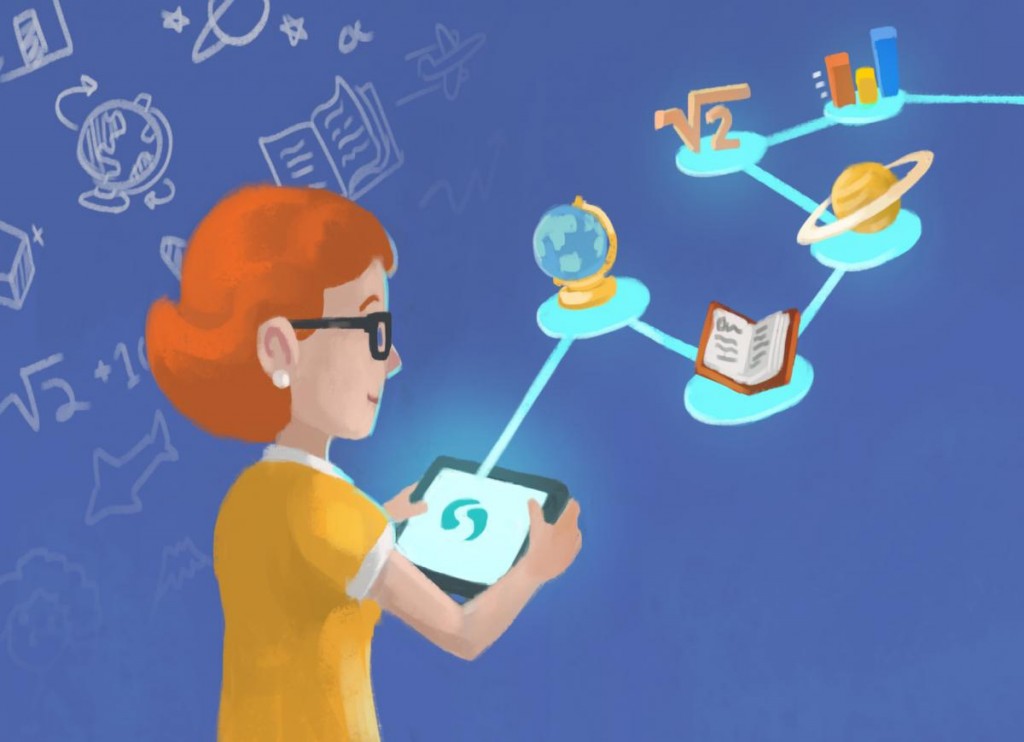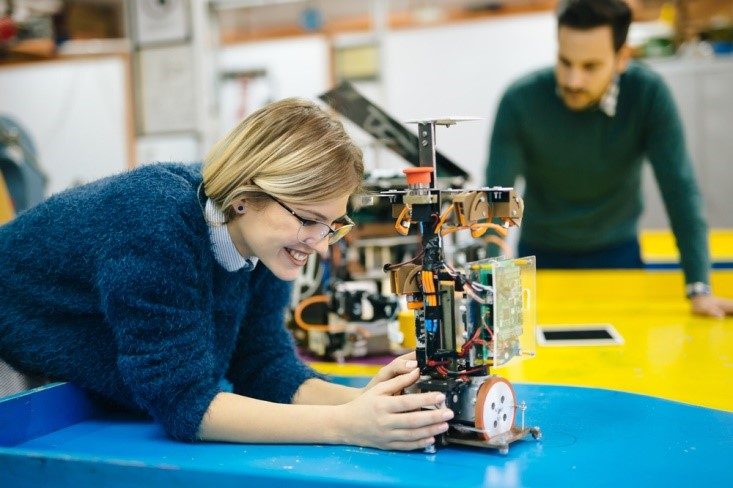RobotLAB Blog
Everything You Need To Know About Robotics in Businesses
EdTech Should Change The Way Teachers Teach
For a long time, teaching was teacher-centered: the teacher dispensed information through lecture, handouts, or presentations; the students absorbed the information by listening and taking notes. It was repetitive, could become monotonous, and left little room for student exploration or creativity. It was also detrimental to students who couldn’t keep pace with the teacher’s lessons or students who learned in way different from the teacher’s presentation
The past ten years have seen a surge in student-centered learning, and the integration of technology into the classroom makes it increasingly easy to create engaging lessons that reach a variety of learners in a variety of ways.
There are many ways that technology has changed and improved teaching methods, making education more meaningful and accessible to all students.

- 0 Comments
- Oct 24, 2019 10:15:00 AM
- Posted by Natalia Galvis
- Topics: EdTech, STEM, STEMchat, Edchat
How Do We Get More Girls Involved in STEM?
Beyoncé famously stated that “girls run the world” and while her sentiment is hopeful, there are still academic fields where girls are under-represented. The world of STEM is still largely male dominated, and with this industry booming, it is important that young girls are awarded opportunities to join in. The problem is not that girls are not interested in STEM subjects but that they are not encouraged to enter these fields or study the subjects at school.

- 0 Comments
- Oct 23, 2019 10:00:00 AM
- Posted by Natalia Galvis
- Topics: EdTech, STEM, STEMchat, WomeninSTEM, Edchat, girlsinSTEM
The Power and Promise of Game-Based Learning
From young learners to adults, games can be used to increase learning. Games have been used by teachers for centuries, and probably thousands of years as a way to engage students in learning. Who doesn’t like games? Perhaps a few people don’t like games. However, games are an excellent way to capture the attention of your students and encourage learning. Why are games beneficial in the learning process, and why do we love them?

- 0 Comments
- Oct 22, 2019 10:10:00 AM
- Posted by Natalia Galvis
- Topics: EdTech, STEM, Learning, STEMchat, Edchat, game-based
How Should We Prepare STEM Teachers?
As the modern world becomes increasingly digital, it will be paramount to create a new generation of innovators in the STEM field. The first step toward creating a more innovative collection of workers in the fields of science, technology, engineering, and mathematics begins in the classroom. Teachers must be properly trained to facilitate STEM lessons to their students and pique their interest from an early age.

We must move all the way back to the way that we train teachers in order to better prepare them to teach STEM subjects. Better teacher education provides an improved platform for all student learning to take place. Everyone wants to see practical ways that we can boost the performance of local STEM programs. The school system can start incorporating some of these key ways that we can help teachers to do their job more effectively.
- 0 Comments
- Oct 21, 2019 10:00:00 AM
- Posted by Natalia Galvis
- Topics: EdTech, STEM, STEMchat, Edchat
How To Use 3D Printing in STEM Classes
one are the days when students could only print on traditional two-dimensional paper. The world of 3D printing is opening up new doors in the classroom setting. With the invention of this technology, teachers can bring lessons to life in a new way that was previously inaccessible. Most classes could benefit from the addition of a 3D printer, but STEM classes can uniquely utilize this new opportunity. The ability to design and physically create small models can be invaluable in these STEM-based courses.

How can educators make the most of the 3D printer in their classroom? Here are just a few ways that this technology can create a more realistic and hands-on lesson to further a child’s grasp of essential concepts.
- 0 Comments
- Oct 18, 2019 12:54:30 PM
- Posted by Natalia Galvis
- Topics: EdTech, STEM, STEMchat, Edchat
Why Should we Invest in STEM Education?
It’s no surprise that careers are becoming more focused in the areas of Science, Technology, Engineering, and Math. According to Edutopia, 80 percent of the fastest growing careers in the US require employees to have some form of STEM education. The U.S. Department of Commerce has reported that over the past ten years, STEM jobs have grown three times as fast as non-STEM jobs. The same study has also reported employees in STEM careers earn 26 percent more than those who are in other careers.

- 0 Comments
- Oct 17, 2019 10:21:49 AM
- Posted by Natalia Galvis
- Topics: EdTech, STEM, STEMchat, Edchat
The benefits of starting to use technology in kindergarten
One of the fears parents often bring up in relation to children and technology is the concern that they are exposed to it too early. Many experts have chimed in trying to define an ideal age at which to allow children to use technology, but it seems to be difficult to agree on how early is too early to get started.

Some parents, teachers and pediatricians advocate a late start, arguing that a frequent use of technology in early childhood interferes with the healthy development of children’s eyesight, brain, and fine motor skills.
However, forcing children to start later than their peers is anachronistic and may put them at a disadvantage: if technology is completely banned from their lives until after their formative years, they will be digital immigrants in a generation of digital natives.
Here are some reasons why it might be beneficial to reach a compromise between the need to preserve the children’s health and the increasing necessity of keeping them up to date with the latest technologies.
- 0 Comments
- Oct 16, 2019 10:00:00 AM
- Posted by Natalia Galvis
- Topics: EdTech, STEM, STEMchat, Edchat
7 Educational Uses for 3D printing
When someone says that they have a 3D printer, many people visualize a printer that produces 3D images on a sheet of paper. In actuality, a 3D printer goes beyond an image on paper and brings the object to life in real 3D. Layer by layer, the 3D printer can replicate images created in CAD programs. Any creation in supported design programs can be brought into the real world. What are some educational values of the 3D printer?

- 0 Comments
- Oct 14, 2019 1:20:00 PM
- Posted by Natalia Galvis
- Topics: EdTech, STEM, STEMchat, Edchat, 3D-Printer
Can Robotics Teach Problem Solving to Students?
Critical thinking and problem-solving skills are essential to success at university and in later life. However, the traditional classroom model has done a poor job of imparting these skills to students. The way children have learned in the classroom for generations has focused on lectures and worksheets. Past generations would depend on group sports, clubs and teenage jobs to impart these vital skills onto students.

However, new ideas suggest that robotics may hold the key to teaching problem-solving skills to students. Using robots to teach real-world skills may be a strange concept, but is it worth exploring? We think so and here’s why.
- 0 Comments
- Oct 11, 2019 10:10:00 AM
Key trends in K12 robotics education
Robotics education is becoming increasingly commonplace in schools. This is largely due to the fact that students in K12 schools will graduate into a workforce that’s rife with technology, in an era where robots will become widely used in our everyday lives.
Even if these kids choose a career other than coding or robotics, learning robotics teaches them many important skills such as analytical thinking, programming, teamwork, collaborative thinking, innovation and more. It can be easily incorporated into STEAM education, which is becoming more popular in schools worldwide.

- 0 Comments
- Oct 10, 2019 10:00:50 AM
Relevant Posts
- Augmented Reality: A Tool for Teaching Students Robot Programming
- Fostering Innovation Through Youth Education in STEM and EdTech
- How Parents Can Foster STEM Learning Beyond the Classroom
- How Robotics Cultivates a Deep Understanding of Mathematics in Students
- RobotLAB Receives EDTech Chronicle 2023 ‘BESTIE’ Award for Landmark Partnership with American Samoa Dept. of Education.
Subscribe to Email Updates
-
I Want To Learn MoreADDITIONAL INFORMATION
